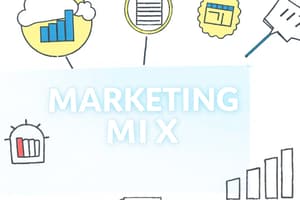Podcast
Questions and Answers
How does an increase in income typically affect consumer spending behavior?
How does an increase in income typically affect consumer spending behavior?
- Demand for lower-priced products increases.
- Demand shifts from lower-priced products to higher-priced products. (correct)
- Demand for higher-priced products decreases.
- Consumers become indifferent to product prices.
What effect does the availability of close substitutes have on price elasticity of demand?
What effect does the availability of close substitutes have on price elasticity of demand?
- It increases the price elasticity of demand. (correct)
- It has no impact on price elasticity of demand.
- It decreases the price elasticity of demand.
- It makes demand less sensitive to price changes.
Which of the following accurately describes fixed costs?
Which of the following accurately describes fixed costs?
- They are only incurred if a company is profitable.
- They increase with more units produced.
- They remain constant regardless of production levels. (correct)
- They vary with production volume.
Why is price considered one of the most important factors in purchase decisions?
Why is price considered one of the most important factors in purchase decisions?
Which of the following pricing methods focuses primarily on comparing prices with competitors?
Which of the following pricing methods focuses primarily on comparing prices with competitors?
What is the correct formula for calculating the total cost of production?
What is the correct formula for calculating the total cost of production?
What role does price play in the marketing mix fundamentally?
What role does price play in the marketing mix fundamentally?
In the context of break-even analysis, which factor is crucial for determining the break-even point?
In the context of break-even analysis, which factor is crucial for determining the break-even point?
Which of the following factors is NOT one of the 5 C’s that influence pricing decisions?
Which of the following factors is NOT one of the 5 C’s that influence pricing decisions?
What is a challenge associated with managing price in the marketing mix?
What is a challenge associated with managing price in the marketing mix?
Which type of market structure is characterized by a single firm controlling the market?
Which type of market structure is characterized by a single firm controlling the market?
What distinguishes monopolistic competition from pure competition?
What distinguishes monopolistic competition from pure competition?
In which type of competition do a few firms dominate the market?
In which type of competition do a few firms dominate the market?
What challenge do manufacturers face with pricing strategies in terms of the grey market?
What challenge do manufacturers face with pricing strategies in terms of the grey market?
Which statement best describes pure competition?
Which statement best describes pure competition?
What is the main focus of the 'second C' in the Five C’s of Pricing?
What is the main focus of the 'second C' in the Five C’s of Pricing?
How do consumers typically respond to price increases for essential goods such as milk?
How do consumers typically respond to price increases for essential goods such as milk?
What pricing strategy is exemplified by Hermès for its luxury handbags?
What pricing strategy is exemplified by Hermès for its luxury handbags?
What distinguishes prestige products from other types when it comes to demand curves?
What distinguishes prestige products from other types when it comes to demand curves?
What best describes the price elasticity of demand for steak compared to milk?
What best describes the price elasticity of demand for steak compared to milk?
Flashcards
Price Elasticity of Demand
Price Elasticity of Demand
A measure of how responsive demand is to a change in price.
Income Effects
Income Effects
How changes in income affect consumer spending habits and demand for different products.
Variable Costs
Variable Costs
Costs that change depending on the level of production.
Fixed Costs
Fixed Costs
Signup and view all the flashcards
Break-Even Point
Break-Even Point
Signup and view all the flashcards
Monopoly
Monopoly
Signup and view all the flashcards
Oligopoly
Oligopoly
Signup and view all the flashcards
Monopolistic Competition
Monopolistic Competition
Signup and view all the flashcards
Pure Competition
Pure Competition
Signup and view all the flashcards
Grey Market
Grey Market
Signup and view all the flashcards
Price's Role in Marketing
Price's Role in Marketing
Signup and view all the flashcards
Price as Value Signal
Price as Value Signal
Signup and view all the flashcards
Price's Strategic Importance
Price's Strategic Importance
Signup and view all the flashcards
Challenges of Pricing
Challenges of Pricing
Signup and view all the flashcards
Pricing's Impact in Purchase Decisions
Pricing's Impact in Purchase Decisions
Signup and view all the flashcards
Five C's of Pricing
Five C's of Pricing
Signup and view all the flashcards
Prestige Pricing
Prestige Pricing
Signup and view all the flashcards
Price Elasticity of Demand
Price Elasticity of Demand
Signup and view all the flashcards
Demand Curves & Pricing
Demand Curves & Pricing
Signup and view all the flashcards
Customer Orientation
Customer Orientation
Signup and view all the flashcards
Study Notes
Chapter 11: Pricing Concepts and Strategies: Establishing Value
- This chapter covers pricing concepts and strategies in marketing.
- Key learning objectives (LOs) are included to guide learning.
- The importance of price in establishing value in marketing is explained.
- The influence of the 5 C's (company objectives, customers, costs, competition, and channel members) on pricing decisions is illustrated.
- Pricing methods (cost-based, competitor-based, and value-based) and strategies (EDLP, high/low, new product pricing) are discussed.
- Pricing tactics targeted at channel members and consumers are identified.
- Legal and ethical issues in pricing are summarized.
- Disney's sophisticated pricing strategies for their amusement parks are highlighted.
- Price is a strategic opportunity to create value and not an afterthought in the overall marketing mix.
- Pricing signals quality; different prices can indicate different levels of quality.
Role of Price in the Marketing Mix
- Price is often a major factor in purchase decisions.
- It's the only element of the marketing mix that generates revenue.
- Managing price is crucial and often complex for marketers.
The Five C's of Pricing
- The 5 C's—company objectives, customers, costs, competition, and channel members—are interconnected to determine pricing strategy.
1st C: Company Objectives
- Profit orientation: Maximizing profits and target return pricing.
- Sales orientation: Focus on sales volume over profit.
- Competitor orientation: Basing pricing decisions on competitive pricing strategies.
- Customer orientation: Focusing on value and understanding consumer needs.
2nd C: Customers
- Understanding consumer response to price is paramount.
- Consumers value products that align with their needs and prices.
Demand Curves & Pricing
- Knowing demand curves reveals relationships between price and demand.
- Demand increases as price decreases and vice versa.
- Prestige products have unique demand curves.
- Premium pricing is a strategy used with prestige products.
3rd C: Costs
- Variable costs change based on production volume.
- Fixed costs remain constant regardless of production volume.
- Total cost is the sum of variable and fixed costs.
- Break-even analysis helps determine the point where revenue equals costs.
4th C: Competition
- Different degrees of competition influence pricing strategies.
- Types of competition include monopoly (one firm), oligopoly (few firms), monopolistic competition (many firms with differentiated product), and pure competition (many commodities at the same price).
5th C: Channel Members
- Manufacturers, wholesalers, and retailers have varied perspectives on pricing.
- Manufacturers need protections from grey market transactions.
Pricing Methods & Strategies
- Cost-based, competitor-based, and value-based pricing methods are used to determine prices.
Psychological Factors
- Value-based pricing comprises different strategies: New product pricing, Everyday Low Pricing (EDLP), and High/Low pricing.
Everyday Low Pricing (EDLP)
- EDLP, or everyday low pricing, saves customers the effort of finding the most affordable product, encouraging consumers to buy at a reasonable rate.
High-Low Pricing
- High-low pricing relies on sales events that incentivize purchases, including discounts and special offers.
New Product Pricing Strategies
- Price skimming and market penetration pricing are common strategies for new products.
Pricing Tactics - Consumers
- Pricing lining, price bundling, and leader pricing are examples of pricing tactics to encourage consumer purchases.
Price Lining
- Price lining sets a price floor and ceiling for a product range.
Price Bundling
- Bundled pricing involves offering multiple products or services at a lower price.
Leader Pricing
- Leader pricing focuses on popular items to attract customers, with the intention of also generating more purchases of complementary products.
Consumer Price Reductions
- Markdowns, coupons, and rebates reduce prices.
Markdowns
- Markdowns are used to clear out obsolete or slow-moving items, while also attracting customers.
Quantity Discounts for Consumers
- Larger quantities often result in a lower per-unit cost.
Coupons & Rebates
- Retailers are responsible for providing coupons, while manufacturers and providers deal with rebate issues.
Business-to-Business Pricing Tactics & Discounts
- Discounts for businesses include seasonal discounts, cash discounts, allowances (advertising and listing), quantity discounts, and uniform delivered pricing.
Seasonal Discounts & Cash Discounts
- Seasonal discounts encourage early purchases.
- Cash discounts incentivize prompt payments.
Allowances
- Advertising and listing allowances can improve consumer behaviour and drive sales.
Quantity Discounts
- Quantity discounts incentivize bulk orders.
Uniform Delivered Pricing
- With uniform delivered pricing, the shipping cost remains the same for anywhere in the region of sale.
Legal & Ethical Aspects of Pricing
- Pricing strategies can relate to misleading advertising, price discrimination, predatory pricing, and price fixing.
Deceitful or Illegal Price Advertising, Price Fixing & Price Discrimination
- Misleading advertising involves presenting a deceptive reference price to attract customers.
- Price fixing involves coordinating with other companies to control prices.
- Price discrimination involves charging different prices to different customers or resellers.
- Predatory pricing involves setting prices very low in order to drive competitors out of business.
Studying That Suits You
Use AI to generate personalized quizzes and flashcards to suit your learning preferences.
Related Documents
Description
This quiz focuses on Chapter 11 of marketing principles, which delves into pricing concepts and strategies for establishing value. It covers essential pricing methods, the influence of the 5 C's, and legal considerations, with a case study on Disney's pricing strategies in amusement parks.




